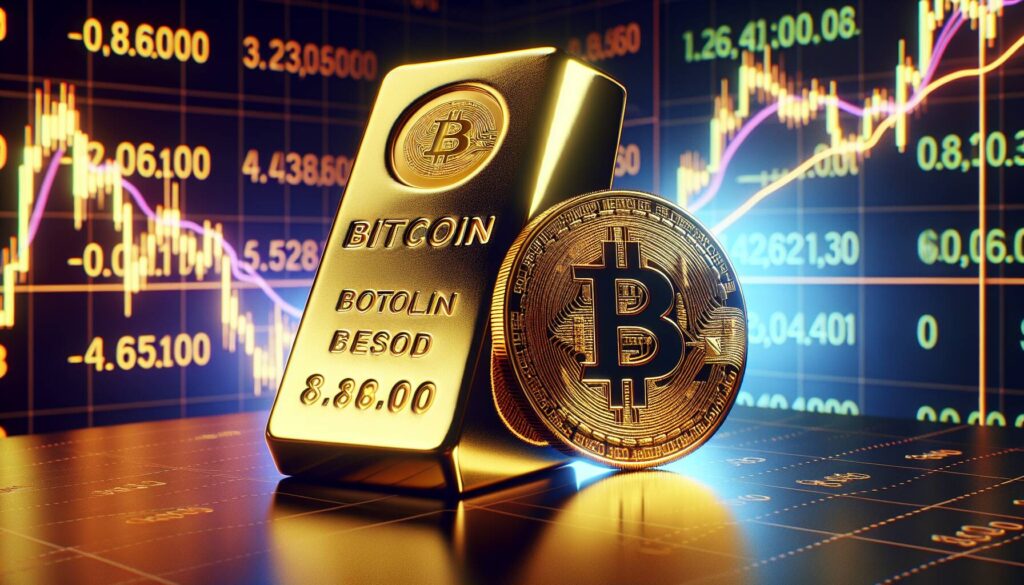The world of cryptocurrency is currently witnessing a pivotal shift, with gold affirming its reputation as a safe haven asset amid escalating concerns over a potential U.S.-led trade war. As gold continues to shine, Bitcoin seems to be struggling to find its footing, resulting in an interesting dynamic between the two assets.
According to data from TradingView, the ratio of Bitcoin’s price to gold’s price has dropped to 34, representing the lowest level since November 14, 2023, and reflecting a noticeable decline of 15.4% since reaching a peak above 40 in mid-December.
This year’s robust performance of gold, with an impressive surge of nearly 10% pushing its price to a record ,877 per ounce, can largely be attributed to safe-haven demand driven by the intensifying U.S.-China trade tensions. As reported by Reuters, the fear of looming tariffs has led to a marked increase in demand for gold within futures markets, with prices in some cases trading significantly higher than spot prices. Notably, financial giant JPMorgan is preparing to ship a staggering billion worth of gold bullion to New York this month, as observed by The Guardian.
As we delve deeper, it’s also worth mentioning that Chinese demand for gold has seen a sharp uptick, particularly during the Spring Festival holidays. Meanwhile, the landscape for Bitcoin is marked by mixed signals. Recent inflows into U.S.-listed spot Bitcoin ETFs have largely stemmed from traders employing non-directional arbitrage strategies. Markus Thielen, founder of 10x Research, noted that this influx, which amounted to billion following the recent inflation data release, could be offset by simultaneous selling, dampening any notable price shifts for Bitcoin.
As the market continues to respond to these evolving dynamics, the relationship between Bitcoin and gold remains a focal point for investors and analysts alike.

Gold and Bitcoin: Safe Haven vs. Struggling Asset
Recent market dynamics illustrate the contrasting roles of gold and bitcoin in today’s economic climate, particularly in the context of ongoing trade tensions.
- Gold’s Status as a Safe Haven:
- Gold has experienced a year-to-date increase of nearly 10%, reaching a record price of ,877 per ounce.
- The rise is attributed to safe-haven demand due to escalating U.S.-China trade conflicts.
- JPMorgan plans to deliver billion of gold bullion to New York, reflecting a significant demand for gold in the face of uncertain economic conditions.
- Bitcoin’s Struggles:
- The bitcoin-gold ratio has dropped to 34, the lowest level since November 14, 2023.
- Bitcoin’s price has decreased by 15.4% since peaking above 40 in mid-December 2023.
- Inflows into U.S.-listed Bitcoin ETFs are mostly speculative, with little impact on price stability.
- Impact of Trade War on Investment Strategies:
- Tariff threats have caused metal product futures prices to increase, driving demand for gold.
- Chinese demand for gold has surged, especially during the Spring Festival holidays.
- Investors may be reassessing their portfolios, considering gold as a hedge against potential market volatility.
“Gold remains a favorable investment during uncertain times, while bitcoin’s volatility may deter risk-averse investors.”
Gold Shines Bright While Bitcoin Struggles: A Comparative Analysis
In a landscape dominated by economic uncertainty and trade tensions, gold is reclaiming its position as a preferred safe haven asset. Recent developments surrounding the U.S.-China trade war have propelled gold prices to impressive heights, achieving a significant year-to-date increase of nearly 10%. The metal reached a record price of ,877 per ounce, driven primarily by heightened safe-haven demand, particularly as trade tariffs loom ominously over global markets.
On the flip side, Bitcoin seems to be losing its spark amidst this environment. The bitcoin-gold ratio has plummeted to 34—its lowest since November 2023—indicating a stark decrease in Bitcoin’s value relative to gold. This decline of 15.4% since its mid-December peak mirrors a waning confidence in cryptocurrencies as a reliable investment during turbulent times. While Bitcoin has its ardent supporters, it struggles to gain upward momentum as traders flock to gold. The contrasting trajectories raise interesting questions about the future of digital currencies versus traditional commodities.
Gold’s current dominance offers several advantages for investors seeking stability. Its appeal is significantly amplified during periods of economic turmoil, attracting a surge in demand from countries like China, especially given the seasonal boost from the Spring Festival. Furthermore, large-scale transactions, such as JPMorgan’s delivery of billion worth of gold bullion to New York, signal strong institutional confidence in the yellow metal. This could potentially alienate Bitcoin investors who might view the shift in market dynamics unfavorably.
However, Bitcoin isn’t entirely without merit. The inflows into U.S.-listed spot Bitcoin ETFs, although largely stemming from non-directional arbitrage trades, indicate ongoing interest in cryptocurrency. Some traders may see Bitcoin as a speculative investment, hoping to capitalize on eventual price recoveries. Nonetheless, this strategy comes with inherent risks, especially as industry insiders suggest that ETF purchases may be counterbalanced by selling positions, thereby limiting any positive price movements.
This evolving market landscape presents distinct opportunities and challenges. Investors seeking stable returns during uncertain economic periods are likely to find gold more appealing. In contrast, risk-takers and crypto enthusiasts might still look favorably upon Bitcoin, albeit with caution. However, it’s clear that the current atmosphere plays into gold’s hands, posing potential dilemmas for Bitcoin’s long-term viability as a “digital gold” alternative in the eyes of traditional investors.

















